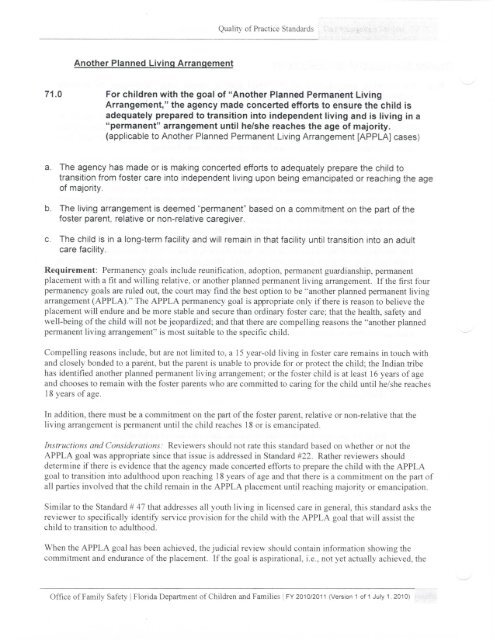Independent Living Program - Florida's Center for Child Welfare
Independent Living Program - Florida's Center for Child Welfare
Independent Living Program - Florida's Center for Child Welfare
- No tags were found...
Create successful ePaper yourself
Turn your PDF publications into a flip-book with our unique Google optimized e-Paper software.
Quality of Practice StandardsAnother Planned <strong>Living</strong> Arrangement71.0 For children with the goal of "Another Planned Permanent <strong>Living</strong>Arrangement," the agency made concerted ef<strong>for</strong>ts to ensure the child isadequately prepared to transition into independent living and is living in a"permanent" arrangement until he/she reaches the age of majority.(applicable to Another Planned Permanent <strong>Living</strong> Arrangement [APPLA] cases)a. The agency has made or is making concerted ef<strong>for</strong>ts to adequately prepare the child totransition from foster care into independent living upon being emancipated or reaching the ageof majority.b. The living arrangement is deemed "permanent" based on a commitment on the part of thefoster parent, relative or non-relative caregiver.c. The child is in a long-term facility and will remain in that facility until transition into an adultcare facility.Requirement: Permanency goals include reunification, adoption, permanent guardianship, permanentplacement with a fit and willing relative, or another planned permanent living arrangement. If the first fourpermanency goals are ruled out, the court may find the best option to be "another planned permanent livingarrangement (APPLA)." The APPLA permanency goal is appropriate only if there is reason to believe theplacement will endure and be more stable and secure than ordinary foster care; that the health, safety andwell-being of the child will not be jeopardized; and that there are compelling reasons the "another plannedpermanent living arrangement" is most suitable to the specific child.Compelling reasons include, but are not limited to, a 15 year-old living in foster care remains in touch withand closely bonded to a parent, but the parent is unable to provide <strong>for</strong> or protect the child; the Indian tribehas identified another planned permanent living arrangement: or the foster child is at least 16 years of ageand chooses to remain with the foster parents who are committed to caring <strong>for</strong> the child until he/she reaches18 years of age.In addition, there must be a commitment on the part of the foster parent, relative or non-relative that theliving arrangement is permanent until the child reaches 18 or is emancipated.Instructions and Considerations: Reviewers should not rate this standard based on whether or not theAPPLA goal was appropriate since that issue is addressed in Standard #22. Rather reviewers shoulddetermine if there is evidence that the agency made concerted ef<strong>for</strong>ts to prepare the child with the APPLAgoal to transition into adulthood upon reaching 18 years of age and that there is a commitment on the part ofall parties involved that the child remain in the APPLA placement until reaching majority or emancipation.Similar to the Standard # 47 that addresses all youth living in licensed care in general, this standard asks thereviewer to specifically identify service provision <strong>for</strong> the child with the APPLA goal that will assist thechild to transition to adulthood.When the APPLA goal has been achieved, the judicial review should contain in<strong>for</strong>mation showing thecommitment and endurance of the placement. If the goal is aspirational, i.e., not yet actually achieved, theOffice of Family Safety | Florida Department of <strong>Child</strong>ren and Families! FY 2010/2011 (Version 1 of 1 July 1, 2010)
















